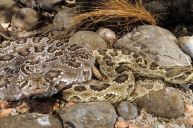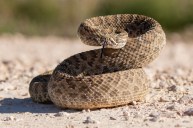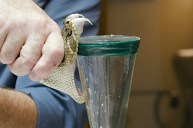There are four types of venomous snakes that roam the United States. Coral snakes are found in wooded, sandy or marshy areas in the South. Water moccasins live in the southeastern states. Copperheads, which vary in color from reddish to golden tan, are found in eastern states. And rattlesnakes live in mountains, prairies, deserts, and beaches - basically everywhere across the country.
Yet, rattlesnakes are a real problem in one city in Texas. An Odessa vet's office reports it's had about a dozen dogs bitten by rattlesnakes in just one day. One puppy died, while the others are still recovering from their bites.
Labor Day weekend vets always see a spike in dogs bitten by rattlesnakes but a dozen in a day seems like a ton! According to a story reported by CBS7 News, vets say spikes in attacks come twice a year when the weather changes around Labor Day weekend and Memorial Day weekend and this heat encourages them to slither into neighborhoods looking for water.
"Most snakes live outside the cities; however, vets warn newly developed communities tend to have a lot of snakes because many of them linger after their habitat is cleared away."
There is a rattlesnake vaccine available for dogs but limited scientific evidence available documenting how much protection it actually provides. Vaccines don't offer 100-percent protection, and antivenom is likely to be administered despite being previously vaccinated. Discuss your options with your veterinarian.
Texvetpets.org, say that most pets will display similar signs in the event of a venomous snakebite. Snakebites are associated with rapidly progressive swelling, bruising, significant pain and a small amount of bloody or black drainage from the punctures. Bites to the head and mouth can lead to difficulty breathing due to the profound swelling that may develop near the airway.
A rattlesnake bite is very scary and clearly, the lack of water is cause for concern. All pet owners should be looking out for their pets and keeping them inside during the day. You can always look for puncture wounds if you're worried and see if there is any swelling which is a clear sign. In addition to dogs, a lot of people are also finding themselves at the hospital so look before you step!
What if this happened to your dog? Do you know the types of snakes in your region? Please leave us a comment below!
WATCH NOW: Learn About the Hognose Snake!




